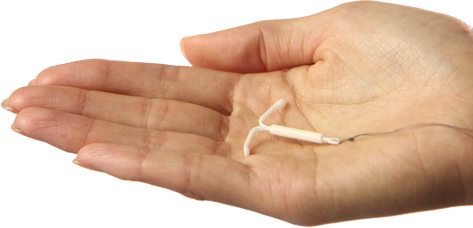An IUD is a tiny, T-shaped device made of plastic that contains hormones or is wrapped in copper. It is inserted into the uterus via the cervix. There is a plastic string tied to the end of the IUD then hangs into the vagina so it can be easily removed and so the patient can know that it still exists in the uterus. If the string is still palpable, the IUD is still in place.
There are two types of IUDs: 1) hormonal IUD. This type of IUD releases levonorgestrel, a type of progestin that prevents pregnancy for 3-5 years. 2) Copper IUD. This is the most commonly used IUD and can prevent pregnancy for up to ten years.
The IUD prevents egg fertilization by damaging or killing sperm. It damages the uterine lining so that the fertilized egg cannot implant. The hormonal IUD affects the mucus in the cervix so sperm cannot pass. It keeps the lining of the uterus thin so implantation can’t happen. Hormones reduce the amount of menstrual bleeding and cramping. The copper IUD is toxic to sperm so the sperm die before fertilizing the egg.
The IUD is inserted by the doctor in just a few minutes. It sometimes requires local anesthesia to insert and there is significant cramping and bleeding in the day or two after insertions. It is easier to do in a woman who has had a vaginal birth in a past. The doctor may ask to see you about a month after insertion to make certain that the IUD is in the proper place. Women must check for the plastic string after every period and must call the doctor if they cannot feel the string. A physical exam or ultrasound can help determine if the IUD is in its proper place.
IUD candidates have the following characteristics:
- You do not have a pelvic infection
- You have only one sex partner who doesn’t have other sex partners
- You want a long-acting, reversible form of birth control
- You don’t want to or cannot use birth control pills
- You are breast feeding
- The copper IUD is recommended for those who have recently had unprotected sex and want emergency contraception
The IUD is highly effective. Using the hormonal IUD, about 0.2 percent of women will become pregnant in the first year. Using the copper IUD, about 0.6 percent of women get pregnant in the first year. Most pregnancies occur because the IUD falls out unnoticed by the woman.
Risks of an IUD include an increase in menstrual bleeding or cramps, spotting between periods, perforation of the uterus, which occurs 0.1 percent of the time. Perforation usually occurs at the time of insertion. About 2-10 percent of the time, the IUD is expelled from the uterus in the first year. It almost always occurs in the first few months following insertion. When this happens, the woman is immediately not protected against pregnancy.
IUDs cost a great deal to insert and do not protect you against STDs. When you need to remove the IUD, you need to pay a doctor to remove it.
The main disadvantage of the hormonal IUD is that it can cause ovarian cysts that resolve after the IUD is removed. It can also cause hormonal side effects such as mood swings, headaches, acne, and breast tenderness.
Pregnancy with an IUD can occur and when it happens, the doctor will recommend that the IUD be removed. Keeping it in can cause miscarriages or preterm birth. You should call your doctor if you have a positive pregnancy test, have severe pelvic pain, have severe vaginal bleeding with clot, or if you have bad smelling vaginal discharge, especially if you have chills and fever along with it. Make sure you are able to feel the string at all times. Call the doctor if you have been exposed to a sexually transmitted disease. For More Detail Visit: Sydney Medical Negligence Compensation

